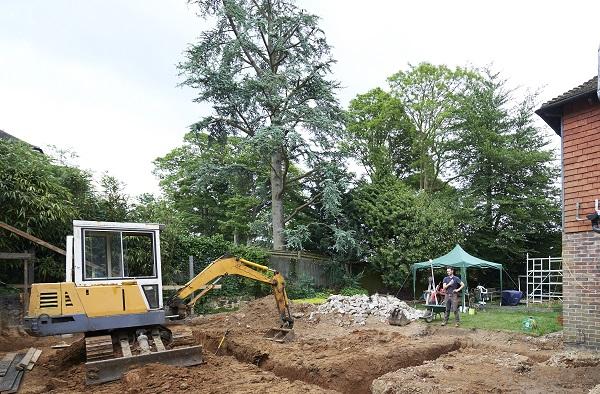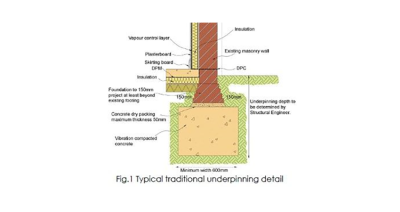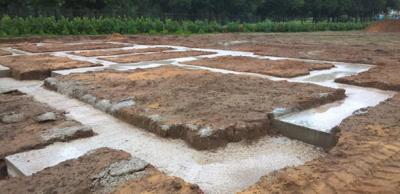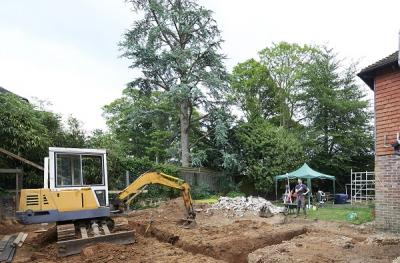Foundations on clay soil
Take extra care when excavating foundations in clay soils, especially if there are trees nearby. Clay soils are made up of 40% water, but trees can change this amount differently throughout the year - causing the soil to shrink or swell with enough force to affect the foundations of a building and so it's vital that the foundation is the right depth to prevent movement.
You can tell if your soil is clay by giving it a squeeze - if it stays in the shape you've made with it and doesn't crumble, it's probably clay (but in very dry conditions even clay will crumble).
Plastic clay
There are three types of clay in the UK, classified by their 'plasticity' (or how much they can change volume because of their water content):
- Clays with the highest plasticity (and so the highest risk) are generally found in the South East of England, stretching up through the East Midlands to the Humber in the North and down to Bath in the West.
- Medium plasticity clays are found in the rest of the South East, across the Midlands and up beyond the Humber Estuary towards the North East. There are also some isolated areas in the North West of England near the coast.
- The rest of England and Wales are generally low plasticity clays - but they still carry some risk.
Minimum depths
Seasonal changes affect clay soils - causing them to swell in winter and shrink in summer. That's why there are minimum foundation depths for each type of clay. Strip, trench fill or pad foundations must be cast at a minimum of 750mm in low plasticity clays, 900mm in medium, and 1000mm in the highest risk areas.
Use the free Foundation Depth Calculator tool
The trouble with trees
But these minimum depths are not enough where there are trees. In drought trees will suck moisture from the clay, shrinking the soil and causing serious settlement and cracking in properties with shallow foundations. Cutting a nearby tree down won't help either.
In normal weather conditions clay adapts to the way nearby trees use water and maintains a steady amount - with the trees drawing out what they need. If you remove a mature tree, the clay won't be able to contain the excess water and will swell - sometimes with enough force to move foundations and lift concrete ground floors, causing serious structural damage.
So cut down the tree or leave it, you're snookered either way! The only answer is to form the foundation below the area affected by the trees.
Not sure of your soil type? Visit http://mapapps2.bgs.ac.uk/ukso/home.html
Dig deep
A little known fact about building control surveyors in areas with shrinkable clay is that they're all tree experts - or at least they often have a 'book of trees' in the car. That's because the type of tree determines the depth of foundation - they all have different water demands. The worst culprits are very tall trees, such as Poplars and other large broad-leafed species.
If you have a 'high water demand' tree the effect on foundation depth can be huge - often needing trenches down to 3m deep, with additional precautions such as compressible boards for heave protection. So how can you determine the depth required?
The Foundation Depth Calculator
Use the freely available LABC Warranty Foundation Depth Calculator, which covers the vast majority of trees found in the UK. All you have to do is enter the type of soil, type of tree, and the distance from the building and this online tool will show you the depth of foundation you need.
This is very handy when pricing a job as you can give a much better idea of the foundation costs to your customer beforehand. However, foundations should always be designed by a competent person prior to commencing work.
View the LABC Warranty Foundations section in their Technical Manual
Read our other articles about working with foundations
- How to get it right: Building a wall on foundations
- How to get it right: Using reinforcement in your foundations
- Offset foundations: For when you're tight to the boundary
- Underpinning of existing foundations
- Trees and foundations
- Raft foundation basics
Please Note: Every care was taken to ensure the information was correct at the time of publication. Any written guidance provided does not replace the user’s professional judgement. It is the responsibility of the dutyholder or person carrying out the work to ensure compliance with relevant building regulations or applicable technical standards.
This article was reviewed and updated on 10 August 2023
Sign up to the building bulletin newsletter
Over 48,000 construction professionals have already signed up for the LABC Building Bulletin.
Join them and receive useful tips, practical technical information and industry news by email once every 6 weeks.
Subscribe to the Building Bulletin




Comments
Depth of foundations when Yew tree is nearby
Submitted 4 years 5 months ago
Reply to: Depth of foundations when Yew tree is nearby
Submitted 4 years 5 months ago
For your specific case it would be best to get another look from your local building control team who'll be pleased to provide free pre-application advice. You can find them by entering the postcode of your proposed project in the 'find your council' bar at the top of our website.
Regards,
LABC
Willow Osier Tree Foundation
Submitted 3 years 10 months ago
Reply
Submitted 3 years 10 months ago
I would advise speaking to your local authority building control team about this one - you can find their direct contact details by using the postcode search in the top righthand corner of this page.
Kind regards
Julie, LABC
bay tree
Submitted 3 years 7 months ago
does it need piling or alternative is possible .
What percent cost difference?
Reply
Submitted 3 years 7 months ago
Kind regards
Julie, LABC
extension
Submitted 2 years 7 months ago
(No subject)
Submitted 2 years 6 months ago
Where any substructure lies close to the zone of influence of a foundation (this can vary depending on the ground conditions and depth of the structure, a 20m deep well in this case) then the advice of a suitably qualified and competent structural or civil engineer should always be obtained. The options that might arise from this could range between there being no effect on the design of the foundations – if the well lies far outside the line of the building so at to have no influence, to anything up to requiring an engineered foundation.
Other considerations would be:
• Does the well have any historic or archaeological significance.? The local planning conservation officer should be consulted.
• Does the well link to a subsoil water course that requires to be protected from contamination? Checks with the Environment Agency, and Rivers and
Canals Trust should be undertaken.
In all cases ensure there is a written record of the advice obtained and any recommendations/designs given and how they were implemented.
Best,
LABC team
Foundations in clay
Submitted 2 years 2 months ago
LABC response
Submitted 2 years 1 month ago
Thank you for your recent enquiry. LABC recommends that you discuss the design of foundations with your local authority building control team, who will be able to consider your project more specifically including the geography and environment of the site.
Best,
LABC team
Add new comment